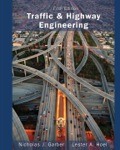
Concept explainers
The capacity of the lane group.
Answer to Problem 5P
The capacity of the lane group is
Explanation of Solution
Given:
The base rate is
Lane width is
Heavy vehicles are
Approach grade is
No on-street parking.
No bus stops.
Bicycle and pedestrian traffic conflicting with this lane group is negligible.
Intersection is in a central business district.
The effective green time for the movement is
The total cycle length is
Formula used:
The adjusted saturated flow rate for a lane group is given by
Here,
The Heavy-vehicle adjustment factor is given by
Here,
The grade adjustment factor is given by
Here,
Parking adjustment factor is given by
Here,
The bus blockage adjustment factor is given by
Here,
The lane utilization adjustment factor is given by
Here,
The right turn adjustment factor for protecting movement on exclusive lane is given by
Here,
The left turn adjustment factor for protecting movement on exclusive lane is given by
Here,
The value of
The capacity of the lane group is given by
Here,
Calculation:
The Heavy-vehicle adjustment factor is calculated as
Substitute
The grade adjustment factor is calculated as
Substitute
Parking adjustment factor is calculated as
Substitute
The bus blockage adjustment factor is calculated as
Substitute
The right turn adjustment factor for protecting movement on exclusive lane is calculated as
Substitute
The left turn adjustment factor for protecting movement on exclusive lane is calculated as
Substitute
The adjusted saturated flow rate for a lane group is calculated as
Substitute
The capacity of the lane group is calculated as
Substitute
Conclusion:
The capacity of the lane group is
Want to see more full solutions like this?
Chapter 10 Solutions
Traffic and Highway Engineering
- A rectangular flume of planed timber (n=0.012) slopes 0.5 ft per 1000 ft. (i)Compute the discharge if the width is 7 ft and the depth of water is 3.5 ft. (ii) What would be thedischarge if the width were 3.5 ft and depth of water is 7 ft? (iii) Which of the two forms wouldhave greater capacity and which would require less lumber?arrow_forwardFigure shows a tunnel section on the Colorado River Aqueduct. The area of the water cross section is 191 ft 2 , and the wetted perimeter is 39.1 ft. The flow is 1600 cfs. If n=0.013 for the concrete lining, find the slope.arrow_forward7.48 An engineer is making an estimate for a home owner. This owner has a small stream (Q= 1.4 cfs, T = 40°F) that is located at an elevation H = 34 ft above the owner's residence. The owner is proposing to dam the stream, diverting the flow through a pipe (penstock). This flow will spin a hydraulic turbine, which in turn will drive a generator to produce electrical power. Estimate the maximum power in kilowatts that can be generated if there is no head loss and both the turbine and generator are 100% efficient. Also, estimate the power if the head loss is 5.5 ft, the turbine is 70% efficient, and the generator is 90% efficient. Penstock Turbine and generator Problem 7.48arrow_forward
- design rectangular sections for the beam and loads, and p values shown. Beam weights are not included in the loads given. Show sketches of cross sections including bar sizes, arrangements, and spacing. Assume concrete weighs 23.5 kN/m'. fy= 420 MPa, and f’c= 21 MPa.Show the shear and moment diagrams as wellarrow_forwardDraw as a 3D object/Isometricarrow_forwardPost-tensioned AASHTO Type II girders are to be used to support a deck with unsupported span equal to 10 meters. Two levels of Grade 250, 10 x 15.2 mm Ø 7-wire strand are used to tension the girders with 5 tendons per level, where the tendons on top stressed before the ones on the bottom. The girder is simply supported at both ends. The anchors are located 100 mm above the neutral axis at the supports while the eccentricity is measured at 400 mm at the midspan. The tendon profile follows a parabolic shape using a rigid metal sheathing. A concrete topping (slab) 130 mm thick is placed above the beam with a total tributary width of 4 meters. Use maximum values for ranges (table values). Assume that the critical section of the beam is at 0.45LDetermine the losses (friction loss, anchorage, elastic shortening, creep, shrinkage, relaxation). Determine the stresses at the top fibers @ critical section before placing a concrete topping, right after stress transfer. Determine the stress at the…arrow_forward
- Show step by step solutionarrow_forwardDraw the shear and the moment diagrams for each of the frames below. If the frame is statically indeterminate the reactions have been provided. Problem 1 (Assume pin connections at A, B and C). 30 kN 2 m 5 m 30 kN/m B 60 kN 2 m 2 m A 22 CO Carrow_forwardThis is an old exam practice question. The answer key says the answer is Pmax = 52.8kN but I am confused how they got that.arrow_forward
 Traffic and Highway EngineeringCivil EngineeringISBN:9781305156241Author:Garber, Nicholas J.Publisher:Cengage Learning
Traffic and Highway EngineeringCivil EngineeringISBN:9781305156241Author:Garber, Nicholas J.Publisher:Cengage Learning
